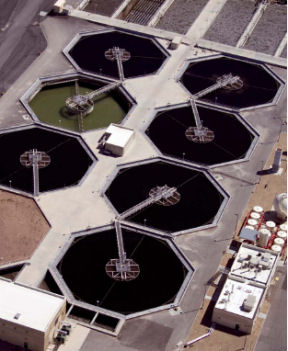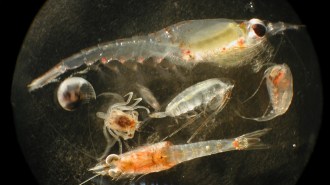- More than 2 years ago
In 1978, during a routine ecological assessment of several British waterways, wildlife biologists discovered an unusually high number of abnormal fish living downstream of two sewage-treatment plants. The fish were considered intersexual because their gonads contained both ovarian and testicular tissue. Nearly 2 decades later, after the development of more-sensitive analytical techniques, researchers provided an explanation. They traced the animals’ reproductive problems to low concentrations of estrogens, known as the female-sex hormones, that had entered the environment in waters released by the sewage plants.

Researchers had found that concentrations as low as a few parts per trillion lead to reproductive abnormalities in fish. “This changed the whole thinking about chemicals in the environment,” says John P. Sumpter, an ecotoxicologist at Brunel University in Uxbridge, England. Having generally focused on chemical pollution at higher concentrations, researchers began to consider that perhaps biologically active chemicals at low concentrations “are the things we should be more concerned about,” he says.
Evidence of reproductive harm to aquatic life chronically exposed to estrogens continues to accumulate, and affected fish have now been found in the United States, Italy, and elsewhere.
Naturally occurring estrogens, a family of closely related molecules, can enter the environment from livestock urine and feces. The hormones in feces and urine of people reach sewage-treatment plants. Synthetic estrogen from birth control pills also turns up in sewage. Small amounts of the chemicals often exit sewage-treatment plants with the treated water. Those plants “are not designed to remove trace pollution,” says Jörg E. Drewes, an environmental engineer at the Colorado School of Mines in Golden.
Recently, scientists and engineers have been investigating how to stem the flow of estrogens into the environment. The researchers are considering fixes both inside and outside the treatment plants.
“There’s a certain optimism that we can control the problem,” says David L. Sedlak, an environmental chemist at the University of California, Berkeley. “I think there are cost-effective solutions out there.”
Priming plants
Federal and state governments regulate what substances a treatment plant must remove. The size of the population that a plant serves, the body of water into which it discharges, and other local environmental factors influence treatment processes, explains Drewes.
The main task of sewage-treatment plants is to remove organic matter from wastewater. Large amounts of decomposing organic matter rob water of oxygen and endanger aquatic life. Some treatment plants also remove nitrogen and phosphorus, nutrients that encourage growth of oxygen-depleting algae. Finally, treatment plants kill pathogens in the water before discharging it.
Research groups have assessed estrogen removal at various facilities. Between 2002 and 2004, Drewes and his colleagues surveyed seven conventional U.S. treatment plants. The group focused on a treatment step during which microbes digest waste from the water.
The water exiting this step had, on average, only 4 percent of the estrogenic activity measured in the water entering this step. However, even that level of activity could cause adverse effects in fish, notes Drewes.
As a first approach to increasing estrogen removal, many scientists and engineers are focusing on treatment steps in today’s plants. “There’s a lot of investment in the current infrastructure,” says Drewes. “That’s why research is ongoing to see whether you can fine-tune existing plants.”
A few trends have emerged. For example, the longer a plant retains waste for bacterial digestion, the better the estrogen removal. During the retention time, the food available to the microbes changes and different types flourish, increasing the chance that the waste will encounter estrogen degraders. Treatment plants with the longest sludge retention times, sometimes several weeks, are typically those designed to remove nitrogen from their wastes. These plants depend on slow-growing bacteria that convert ammonia to nitrate.
Kung-Hui Chu, an environmental engineer at Texas A&M University in College Station, went in search of strains capable of breaking down estrogens. She and her colleagues sampled degrading waste from a treatment plant in Knoxville, Tenn. For 6 months, they grew the microbes in a flask with estrogen as the only food source.
The researchers isolated 11 bacterial strains that break down 17-beta estradiol, the main form of naturally occurring estrogen, to a form called estrone. That degradation continued for at least 7 days.
However, getting rid of estrone proved more difficult. Two other strains reduced the concentration of estrone measurably in 5 days but couldn’t finish the job. The researchers found just one strain that completely degraded 17-beta estradiol to compounds free of estrogenic activity, and it took 5 days to do so. The team reports its results in the Jan. 15 Environmental Science & Technology.
Now that they’ve identified specific strains, Chu and her colleagues are investigating how abundant the estrogen-degrading microbes are in treatment plants. They would like to figure out the operating conditions that are most favorable to these bacteria, so that the microbes can “do the degradation work for us,” says Chu.
Later stages of water treatment can also remove estrogens. Studies have shown that chlorine, commonly used to disinfect treated water, reacts with and removes estrogen. But those studies also reported the formation of by-products that may cause cancers.
Ozonation, a disinfection process used principally in drinking-water treatment, also removes estrogen, but concerns over cost make its use rare among wastewater-treatment plants, notes Sedlak.
More-advanced treatment options could be added to plants, but they’d be expensive, notes Chu. “From an economic point of view,” she says, engineers are initially focusing on improving the microbial degradation of estrogen.
Wetland wager
Estrogen-removal strategies are also being considered outside treatment plants. Sedlak and his colleagues have investigated wetlands engineered to remove contaminants. Some municipalities, such as the Orange County Water District in California, already use engineered wetlands to aid in nitrogen removal.
Characterized by their dense plant growth, wetlands support many bacteria and can be designed so that water moves slowly through their channels. An engineered wetland, put in place at a treatment plant’s discharge point, would provide an additional microbial-degradation step that might also break down estrogens.
In 2002, Sedlak’s group measured the removal of estrogens from a test wetland thick with cattails and bulrushes. The researchers tracked changes in hormonal concentration as estrogen-spiked water moved through the site for 3.5 days. The researchers found evidence of microbial degradation of the hormone along with some adsorption to plant surfaces. When the water exited the wetlands, its estrogen concentration had fallen by almost 40 percent from the initial value.
Sedlak says that engineered wetlands with longer water-retention times would probably remove even more estrogen. And other designs might provide more opportunity for degradation. Subsurface wetlands, for example, force the water to travel underground through gravel or sediments that harbor microbial colonies.
Researchers are also investigating whether engineered wetlands—in combination with the lagoon systems that farmers often use to handle manure—can protect watersheds near livestock operations. Nancy W. Shappell of the U.S. Department of Agriculture’s Agricultural Research Service in Fargo, N.D., and her colleagues examined barns housing more than 100 pigs at North Carolina Agricultural and Technical State University in Greensboro.
During the study, water flushed manure out of the barns into a pit. The resulting slurry next entered a lagoon, and then continued into test wetlands. Finally, the water moved to a storage pond before being used to flush the barns again. The water remained in the wetlands between 20 and 50 days, depending on the time of year.
In the Jan. 15 Environmental Science & Technology, the researchers report that the wetlands decreased the estrogenic activity of the water by 83 to 93 percent. Researchers haven’t yet examined how well lagoon-wetland systems would handle larger livestock operations, which can house thousands of animals.
Sedlak says, “One of the challenges associated with wetlands is understanding their reliability.” There’s little known about the effects of seasonal changes or about what wetland configurations are most successful for hormone removal. “The science there is in its infancy,” he notes.
Taking action
With the continuing development of low-cost approaches to removing estrogen from wastewater—and the availability of more-expensive, advanced treatments usually reserved for drinking water—”the scientific community is now trying to provide a toolbox for water utilities,” Sedlak says. Without regulations requiring estrogen removal, however, it’s unclear whether water utilities will use these options.
“You can design plants that take care of these problems,” notes Drewes. “The question is, Is the community willing to spend that money?” Moving beyond current federal and state standards would require widespread community support.
Estrogen is not the only compound traveling through water systems that raises concern (see “Dealing With Drugs,” below). “I think we need to focus on determining which chemicals put our environment most at risk,” says Shappell. That would entail investigating which compounds persist in treated wastewater at concentrations that have biological activity.
Adds Sumpter, “There are some very interesting questions to ask about how you decide what to focus on and whether the decisions you make are in the best interest of conserving your biodiversity.”
Dealing With Drugs
Are pharmaceuticals a problem in wastewater?
With the discovery that small concentrations of naturally occurring and synthetic estrogens can adversely affect aquatic wildlife, “there’s now a lot of interest across the whole suite of pharmaceuticals,” says John P. Sumpter, an ecotoxicologist at Brunel University in Uxbridge, England. “These chemicals are by definition biologically active. If not, you shouldn’t be taking them.”
Optimizing operations at sewage-treatment plants could reduce pharmaceuticals as well as hormones. Diana S. Aga, an analytical chemist at the State University of New York at Buffalo, and her colleagues studied the removal rate of two medical compounds—an X-ray–contrast agent and an antibacterial drug—that frequently turn up in treated water.
In the Dec. 1, 2006 Environmental Science & Technology, the researchers reported that slow-growing microbes called nitrifying bacteria, which convert ammonia to nitrate, can also degrade those two pharmaceuticals. The group studied a sewage-treatment plant in Amherst, N.Y., that relies on a two-stage microbial process. The first stage retains the waste for 6 days. The second, which encourages the growth of nitrifying bacteria, keeps the waste for 49 days. While the removal of the two compounds was negligible in the first process, the second took care of 61 percent of the contrast agent and 50 percent of the drug.
“If you make the sludge-retention time appropriate for growing these nitrifying bacteria, you may solve a lot of these problems,” says Aga.
Considering the precedent of natural and synthetic estrogens, concern over other pharmaceuticals is legitimate, but there is little evidence yet that they are affecting aquatic wildlife, says Sumpter. And with the vast differences among classes of drugs, “the trick is, How do you go about selecting the few that are going to be the ones you’re concerned about?” He adds that researchers are in the “very early stages” of determining the best way to categorize the compounds.







